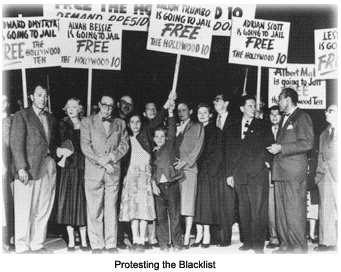The Hollywood Blacklist came into being in 1947 when the House Committee on Un-American Activities (HUAC) began to summon certain Hollywood entertainment professionals on the suspicion that their work was communist-inspired. As the media began extensive coverage of the proceedings, some writers, producers, and directors became known as the "Hollywood Ten."
 The Ten declined to tell HUAC members whether or not they were members of the Communist Party. They maintained that the committee's queries infringed upon their rights under the Constitution. Due to their lack of cooperation, the House of Representatives voted 346 to 17 to approve contempt citations.
The Ten declined to tell HUAC members whether or not they were members of the Communist Party. They maintained that the committee's queries infringed upon their rights under the Constitution. Due to their lack of cooperation, the House of Representatives voted 346 to 17 to approve contempt citations.
All 10 served time in 1950 for up to a year in prison, fined $1,000, and were “blacklisted.” From then on, they faced a difficult time finding a job anywhere in media-based production. The blacklist eventually grew to 150 names and persisted up to the 1960s.
The "infamous" Hollywood Ten
The Ten consisted of Alvah Bessie, Herbert Biberman, Lester Cole, Edward Dmytryk, Ring Lardner, Jr., John Howard Lawson, Albert Maltz, Sam Ornitz, Robert Adrian Scott, and Dalton Trumbo.
But the witch hunt in Hollywood was not over.
A second wave of subpoenas, along with the Mephistophelian "graylist," appeared in 1951. Three former FBI agents created American Business Consultants in 1947. They published a magazine, Counterattack, and, in June 1950, the bible of the graylist, Red Channels: The Report of Communist Influence in Radio and Television.
Altogether some 500 people from the entertainment industry were black or graylisted. The graylist was a supplimentary list of writers and entertainers suspected, sometimes, of no more than lending a name as a "co-sponsor" of an event that was determined to have been "subversive."